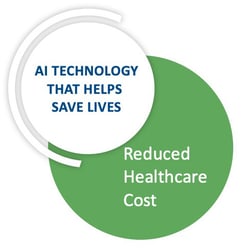Radiologists who use the advancement of artificial intelligence (AI) are better at making breast cancer diagnoses, and their practices can benefit financially from more patient referrals. These benefits from AI also have a broader ripple effect across the healthcare system—namely, the fact that using AI solutions for mammography reduces healthcare costs for both providers and patients.
Increased Efficiency and Earlier Diagnoses
AI-based CAD can drastically reduce flags and false positives per images (FPPI) in mammogram scans. Studies have shown that false positives can take between 3-7 additional seconds to read and disregard—and according to in-practice experience research published in JACR and a study by the MD Anderson Cancer Center, mammograms read with CureMetrix diagnostic software cmAssist® had 69% fewer false positive marks, over old CAD tools, potentially saving an imaging practice 400 hours in labor per year.
Speaking of labor, many practices are constrained by resources or geography, and cannot hire every specialist they need. This is why up to 80 percent of mammograms are read by general practice radiologists without specific training in mammography, and nearly one third of breast cancer cases are missed in early mammogram screenings. AI tools like cmTriage™ and cmAssist® save staffing costs by allowing your practice to provide the best in class care with the talent you have. Radiologists using AI-based CAD software can detect subtle patterns in a mammogram that a human eye might otherwise miss, particularly in dense breasts. One study found that use of cmAssist increased radiologists’ cancer detection rates by 27%.
AI can also reduce costs by allowing doctors to screen for multiple diseases with one mammogram scan. cmAngio™, another CureMetrix AI tool in development, works with existing radiology mammography hardware and leverages the mammogram to find, score and assess marks that might indicate breast arterial calcification, an early sign of coronary heart disease. This is crucial since according to the CDC one in five women nationwide will die from coronary heart disease each year, and 65 percent of those who die will show no outward symptoms. cmAngio saves providers money by efficiently screening for heart disease while a woman is already in for a mammogram, prompting them to take preventative steps or get treatment earlier. This lowers costs for healthcare systems, too, by reducing the number of severe, untreated heart disease cases that require expensive interventions.
Fewer Costs and Better Outcomes for Patients
AI saves lives by catching both breast cancer and soon, coronary heart disease, earlier. Importantly, it’s also a great equalizer when it comes to healthcare costs, and can actually help more women access better care. Because AI reduces the number of false positives per image (FPPI), a practice that uses AI-based CAD may not recall as many women for additional screening. This means fewer women having to shoulder the cost of time off work, childcare and rearranging other responsibilities in order to come back in for more screening or a biopsy.
cmAngio, the AI tool that scans for signs of heart disease in a woman’s mammogram, saves patients even more time and money by allowing them to get scanned for multiple diseases at once, and get treatment for cardiac conditions earlier. Coronary heart disease is one of the leading causes of death for women, but 80-90 percent of all heart attacks and strokes can be prevented when patients are referred to a cardiologist early.
AI for mammography reduces healthcare costs for both healthcare providers and patients alike. It increases efficiency for radiology practices, enables earlier diagnoses and prevents needless mental anguish and financial impact for patients. It also helps patients access better care and get treatment for cancer and heart disease earlier. For heart disease detection alone, leveraging AI and the mammogram can provide a potential $30 billion healthcare impact over five years. It’s an investment that truly pays off many times over.
Request more information and learn more about how CureMetrix AI can reduce costs, increase efficiency and lead to better outcomes for your patients here.

